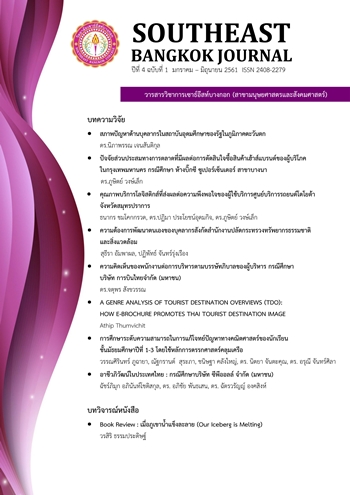A GENRE ANALYSIS OF TOURIST DESTINATION OVERVIEWS (TDO): HOW E-BROCHURE PROMOTES THAI TOURIST DESTINATION IMAGE
Main Article Content
บทคัดย่อ
งานวิจัยปริจเฉทวิเคราะห์ (Genre Analysis) นี้มีวัตถุประสงค์เพื่อจะระบุโครงสร้างอัตถภาค (Move) และ มุ่งจะอธิบายลักษณะทางภาษาของอิเล็กทรอนิกส์โบรชัวร์ ซึ่งผลของงานวิจัยนี้จะมีบทบาทในการพัฒนาสื่อการเรียนการสอนของวิชาในกลุ่มภาษาอังกฤษเพื่อวัตถุประสงค์เฉพาะ (English for Specific Purposes) งานวิจัยนี้ใช้รูปแบบการศึกษาปริเฉทโดย Swale (1990) และ Bhatia (1993) โดยได้เก็บรวบรวมข้อมูลจากโบรชัวร์ของเว็บไซต์ Amazing Thailand ซึ่งผลิตโดยแผนกสื่อและประชมสัมพันธ์ ข้อมูลบทย่อของ 30 สถานที่ท่องเที่ยวในประเทศถูกเลือก ผลที่ได้คือคลังภาษาที่มี 2,367 คำ ผลของงานวิจัยบ่งชี้ 5 อัตถภาค และอนุวัจน์ (Step) ซึ่งพบในบางอัตภาค ส่วนประกอบส่วนใหญ่ของบทย่อคือข้อมูลเท็จจริง (Factual Information) แต่ผู้เขียนมีอิสระในการใช้กลยุทธ์ต่างๆในการประชาสัมพันธ์แหล่งท่องเที่ยว ซึ่งกลยุทธ์เหล่านี้ถูกพบในอัตถภาคที่ 3 (Establishing Credentials)
Article Details
เอกสารอ้างอิง
Beerli, A., & Martin, J. D. (2004). Tourists' characteristics and the perceived image of tourist destinations: A quantitative analysis - A case study of Lanzarote, Spain. TOURISM MANAGEMENT, 25(5), 623-636.
Bhatia, V. K. (1993). Analyzing Genre: Language Use in Professional Settings. London: Longman.
Bhatia, V. K. (2005). Generic patterns in promotional discourse, in: H. Halmari & T. Virtanen (Eds.), Persuasion across genres. Amsterdam: John Benjamins Publishing, 213-226.
Biber, D., Connor, U., & Upton, T. (2007). Discourse on the Move: Using Corpus Analysis to Describe Discourse Structure. Amsterdam: John Benjamins.
Henry, A., & Roseberry, R. L. (1996). A corpus-based investigation of the language and linguistic patterns of one genre and the implications for language teaching, Research in the Teaching of English, 30(4), 472-489.
Huang, S. (2015, December). A Genre-based Analysis of Brief Tourist Information Texts. Paper presented at the JISEM 2015: Joint International Social Science, Education, Language, Management and Business Conference. Chongqin, China.
Hyland, K. (2004). Disciplinary discourses: Social interactions in academic writing. Ann Arbor: University of Michigan Press.
Hyland, K. (2009). Academic Discourse. London: Continuum.
Lam, P. (2006, June). “Tree-lined or tree-fringed?” A corpus-driven approach to the study of the adjectival compounds in English travel and tourism industry texts. Paper presented at the 3rd IVACS group International Conference on Language at the Interface. University of Nottingham, Nottingham, the U.K.
Lou, B., Huang, T., Wu, H.N., Yang. (2015). X: Data-driven H∞ control for nonlinear distributed parameter systems IEEE Trans. Neural Netw Leaarn Syst 26(11).
Matt, H. (2007). How promotional language in press releases is dealt with by journalists: Genre mixing or genre conflict? Journal of Business Communication, 44(1), 59-95.
Moya Guijarro, A. J. (2006). The continuity of topics in journal and travel texts: A discourse of functional perspective. Functions of Language, 13(1), 37-76.
Nolan, S.D. (1976). Tourists’ use and evaluation of travel information sources. J. Travel Res, 14(3), 6-8.
Panseeta, S., & Todd, R.W. (2014). A genre analysis of 5-star Hotels' Responses to negative Reviews on TripAdvisor. REFlections, 17(2) 5-13.
Swales, J. M. (1990). Genre Analysis: English in Academic and Research Settings. Cambridge: Cambridge University Press.
Vergaro, C. (2004). Discourse strategies of Italian and English sales promotion letters. English for Specific Purposes, 23(2), 181-207.
Wildes, V., & Nyheim, P. (2009). Business Writing for Hospitality. Upper Saddle River, NJ: Pearson Prentice Hall.
Yang, W. (2012). Analysing and teaching keywords in hotel brochure text. LPS Journal, 3(1), 32-50. Retrieved from http://lsp.cbs.dk
Zhang, H., Xu, F., Lu, L. & Lei, Y. (2015). Cultural capital and destination image of metropolitans: A comparative study of New York and Tokyo official tourism websites in Chinese, Journal of China Tourism Research, 11(2), 121-149.


